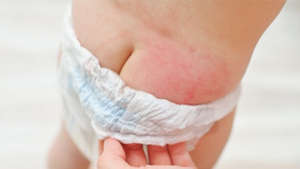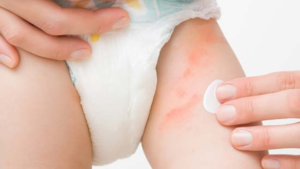Nappy rashes are a common concern for parents with young children in diapers. These uncomfortable and sometimes painful skin irritations can lead to distress for both the child and their caregivers. In this comprehensive guide, we will explore the causes, symptoms, and effective strategies for preventing and treating nappy rashes in children, ensuring their comfort and overall well-being.
Understanding and Preventing Nappy Rashes in Children.

What is Nappy Rashes?
Nappy rashes, also known as diaper rashes, are red, inflamed patches of skin that develop in the diaper area of infants and young children. These rashes can be caused by various factors, most commonly prolonged exposure to moisture, friction, and irritants present in urine and stool. The warm and moist environment inside a diaper provides an ideal breeding ground for the growth of bacteria and fungi, contributing to the development of nappy rashes.

Causes of Nappy Rashes:
- Prolonged Moisture: Leaving a wet or soiled diaper on for an extended period can lead to skin breakdown and irritation.
- Friction: Rubbing of the diaper against the baby’s sensitive skin can cause redness and discomfort.
- Chemical Irritants: Some babies may be sensitive to certain diaper brands or detergents, leading to an allergic reaction.
- Bacterial and Fungal Infections: The warm and damp environment of a diaper can promote the growth of bacteria and yeast, worsening the rash.
- Introduction of Solid Foods: As babies start consuming solid foods, their stool composition changes, which can lead to more acidic and irritating bowel movements.
Symptoms of Nappy Rashes:
Recognizing the early signs of a nappy rash is crucial for prompt intervention. Common symptoms include:
- Red, inflamed, and tender skin in the diaper area.
- Small red bumps or pustules on the skin.
- Peeling or chafing of the skin.
- Discomfort or fussiness during diaper changes.
- Crying or irritability when the affected area is touched.
- A mild rash can progress to severe redness, swelling, and blisters if left untreated.
Prevention Tips:
Fortunately, there are several effective measures parents can take to prevent nappy rashes in children:
- Frequent Diaper Changes: Regularly change your child’s diaper every 2 to 3 hours, and immediately after bowel movements, to reduce prolonged exposure to moisture.
- Gentle Cleansing: Use fragrance-free and alcohol-free baby wipes or warm water and a soft cloth to clean the diaper area during each change. Avoid rubbing the skin vigorously.
- Air Time: Give your child’s bottom some diaper-free time to allow the skin to breathe and stay dry.
- Barrier Protection: Apply a thin layer of zinc oxide or petroleum-based diaper rash cream during each diaper change to create a protective barrier between the skin and moisture.
- Choose the Right Diapers: Opt for breathable, hypoallergenic diapers that fit your child properly to reduce friction and irritation.
- Avoid Irritating Products: Use gentle laundry detergents and avoid harsh soaps or products that may contain irritating chemicals.
Nappy rashes are a common concern for parents with young children, but with proper care and preventive measures, they can be managed effectively. Regular diaper changes, gentle cleansing, barrier protection, and providing diaper-free time are essential steps to keep your child’s skin healthy and free from irritation. If the rash persists or worsens despite preventive measures, consult a pediatrician for appropriate diagnosis and treatment. Remember, a comfortable and happy baby begins with a healthy diaper routine.









